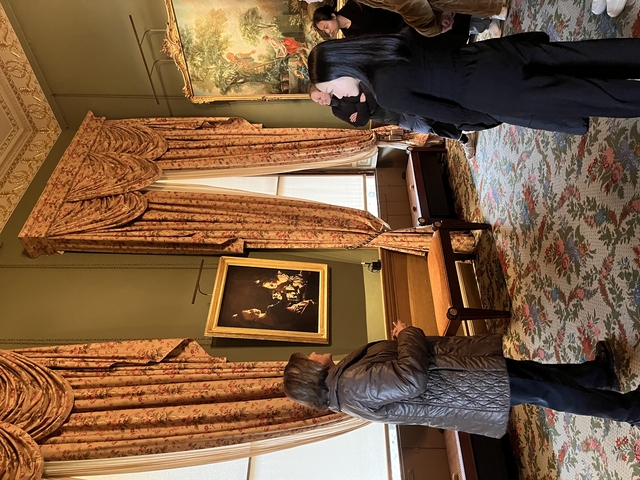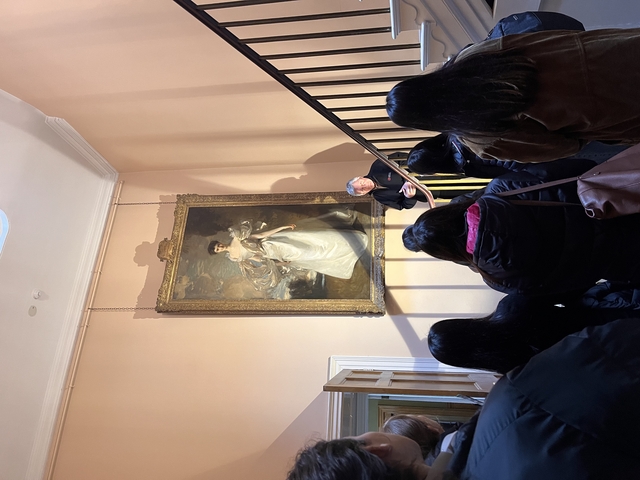
We sat down with Disha Shanbhag, a MSc Digital Anthropology student, to chat about her volunteering experience with Kenwood House as part of the February 2023 Social Hackathon.
Would be you able to introduce yourself?
Hi, my name is Disha. I study MSc Digital Anthropology at UCL.
Why did you want to take part in the Social Hackathon?
This is my only year on campus, so the Social Hackathon was my way of getting some exposure outside of class.
Would you be able to talk a bit about your experience at the Social Hackathon?
The Social Hackathon took place at Kenwood House with English Heritage. Kenwood is known for a lot of really important paintings and other heritage items. The most famous one is the Rembrandt.
The Spotlight Talks are when a volunteer spends about half an hour looking just at one particular painting or an artifact and explaining to you what the history of it is, giving interesting anecdotes. There’s a lot of processes about it being absolutely factual and ethically appropriate. The 15-30 minute talks take place every week for whoever visits Kenwood, and it’s a way to engage the people who are there.
We were there looking at the Spotlight Talks, preparing a review for them. We were introduced to the speakers, given Spotlight Talks, and taken around the place. We basically got to experience what spending a day at Kenwood would look like and how the talks take place. We were taken through the whole process of how, as a volunteer, you are onboarded, and the amount of time and labour that every volunteer puts in to develop a Spotlight Talk and then how it is delivered. That was the first half of the day. It was a great experience because we were in the English countryside, in a way, and it was peaceful and really fun getting to listen to people talk about paintings and history.
The later half we spent reviewing and understanding the different contexts and stakeholders and what kinds of backgrounds the volunteers came from. Then there were a number of breakout sessions and discussions about what we could do in the time we had.
It was quite interesting because we, as third-party consultants and students, got to be part of a different environment for a day. Because some of the people that volunteer at Kenwood House are in retirement, this was kind of a recreational activity for them. A lot of them shared how this is such a big part of their identity now because they’ve been doing it for about 10-15 years. And because we got to be with the volunteers for such a long time, it was really fun to see how such an initiative is so ingrained and social in a way, and how it’s not just about the people who come to Kenwood but so much about the volunteers themselves – how they boost their moral and the quality of the life they lead in general.
Was this your first time taking part in a Social Hackathon?
Yes!
What made you want to take part in the Social Hackathon?
I studied English Literature as my Undergraduate and paintings were a big part of what I studied. Since I’m now studying the digital world, it’s not something that I’m involved with in general. So this is something I wanted to do as an escape during reading week – to do something that I’m really interested in but can’t do academically at present.

This is something I wanted to do as an escape during reading week – to do something that I’m really interested in but can’t do academically at present.
Do you feel that you were able to make a difference through the Social Hackathon?
Since it was such a short period of time, it doesn’t feel fair to look at the experience in terms of what the outcome was. But if I have to talk about outcome, I felt like it was more of a way for us to be tools for the administrator there to understand how to evaluate the program. If that was the intent of the day, then I think we were successful in doing that! Presenting them with a different perspective – I think we could do that there.
Did you develop an evaluation method for Kenwood House to use?
Yes, at the end of the day, after a lot of deliberations and discussions, we came up with survey methods and questions to create a questionnaire to evaluate these spotlight talks, and also had discussions about media and PR. Because most of us were young people and at Kenwood the volunteers especially are of older ages, they wanted a fresh, young perspective of looking at things. I think that was also a way to find out the interests of young people and in what ways they could get more young audiences to Kenwood.
Were there any new skills or experiences that you took away from the Hackathon?
Firstly, it was such a multi-disciplinary cohort that was present there. And because it was during reading week, everyone was away from the pressure and were just there to interact, to chip in, and just to find out more about what the place was about.
Secondly, because the cohort was so multi-disciplinary, and I come from a qualitative research background, I am used to just looking at things from that perspective. But because I was in a space where I was told to also develop quantitative ways of measuring and evaluating the spotlight talks, and also being part of the cohort that was looking at things in different ways, it was really interesting to understand that there can be multiple ways of looking at the same issue. There was collaboration, teamwork, and just exposure to a lot of different viewpoints.
What did you enjoy the most about your experience?
The architecture of the place! The biggest chunk of the day we spent in a really old English kitchen. There were these really ancient pots and pans surrounding us whilst we were discussing things, so it felt quite fun because it felt like you were living in history. It was not just about history or about paintings – you felt like you were a part of something really cool.
Even in the washrooms, the taps were from the 1830s! It felt quite memorable, because I don’t think any of the students there would have gone out of their way to visit a place like that. It was because of this event that we ended up there. Because of that, it was not just about helping them, but also experiencing something.

It felt like you were living in history. It was not just about history or about paintings – you felt like you were a part of something really cool.
Were there any challenges that you encountered on the day?
I think because it was just a one-day event, it felt like everything was chunked in together so there was a feeling that we didn’t have enough time. And then because of that there was a feeling like we weren’t doing enough. Like, can we do more? I think that was something that concerned a lot of us because we felt like we could be doing more if we were just given a bit more time.
Would you like to take part in the Social Hackathon again?
I would, because just the energy of the place and what they were doing felt so genuine and authentic that I felt like I would love to be a part of it.
Thank you to Disha for sharing her experience at the Social Hackathon! If you are interested in Kenwood House, you can learn more about them here.
You can also learn more about the Social Hackathons here, and keep an eye out for future Hackathons through our newsletter and social media.


